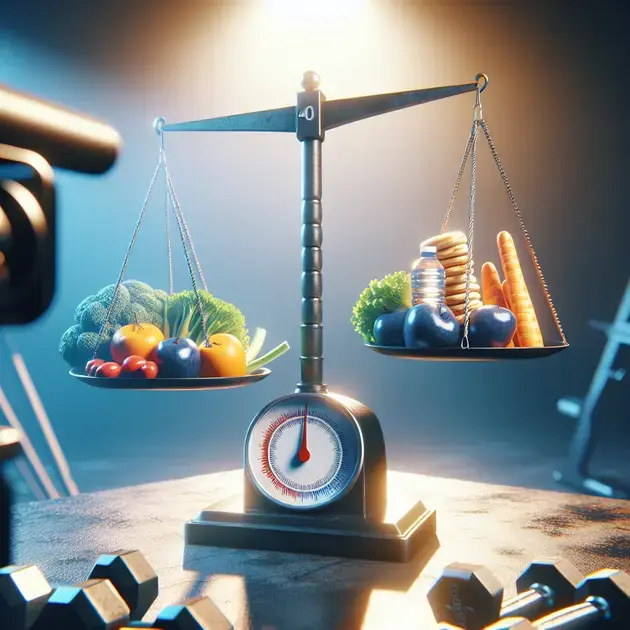In today’s world, where obesity rates are on the rise, understanding the role of calories in weight loss is more important than ever. Many people struggling with weight issues often overlook the basic principle that weight management ultimately comes down to the balance of calories consumed versus calories burned. By grasping this fundamental concept, individuals can make informed decisions about their diet and exercise routines to achieve their weight loss goals effectively.
One of the key aspects of losing weight is realizing that not all calories are created equal. While it is essential to create a calorie deficit to shed pounds, the quality of the calories consumed also plays a significant role in overall health and well-being. Focusing on nutrient-dense foods that provide essential vitamins and minerals, along with the right balance of macronutrients, can help support weight loss efforts while ensuring the body receives the necessary nutrition for optimal functioning.
Understanding Caloric Balance for Weight Loss
Understanding caloric balance is crucial for effective weight loss. It involves the relationship between the calories you consume through food and drinks versus the calories you burn through physical activity and basic bodily functions. To achieve weight loss, you need to create a caloric deficit, meaning you need to consume fewer calories than your body expends.
A helpful way to track your caloric balance is by using apps like MyFitnessPal or Lose It!. These apps allow you to log your daily food intake and exercise, giving you a clear picture of your caloric consumption and expenditure. By monitoring this balance, you can make adjustments to your diet and activity level to reach your weight loss goals.
In addition to tracking calories, understanding the quality of the calories you consume is also important. Nutrient-dense foods play a key role in weight management and overall health. These foods are rich in essential nutrients like vitamins, minerals, and fiber, while being relatively low in calories.
To optimize your weight loss journey, focus on incorporating nutrient-dense foods into your diet. Websites like ChooseMyPlate.gov provide valuable resources on building a healthy eating pattern with nutrient-dense foods. By prioritizing these foods, you can improve your nutritional intake while supporting your weight loss efforts.
In summary, mastering caloric balance and prioritizing nutrient-dense foods are essential components of successful weight loss. By using tools like calorie tracking apps and incorporating healthy eating habits, you can achieve your desired results in a sustainable manner.
Importance of Nutrient-Dense Foods in Weight Management
When it comes to weight management, the quality of the food you eat is just as important as the quantity. Nutrient-dense foods provide essential vitamins, minerals, and other nutrients that support overall health and well-being. By focusing on these foods, you can optimize your nutrition while managing your weight.
An effective way to incorporate more nutrient-dense foods into your diet is by meal planning and preparation. Websites like Cooking Light and EatingWell offer a variety of recipes and meal ideas that prioritize nutrient-rich ingredients. By planning your meals ahead of time and cooking at home, you can ensure that nutrient-dense foods are a central part of your diet.
In addition to meal planning, it’s important to understand the impact of nutrient-dense foods on your body. Websites like Healthline and Mayo Clinic provide in-depth information on the benefits of these foods for weight management and overall health. By educating yourself on the importance of nutrient density, you can make more informed choices about what you eat.
Overall, nutrient-dense foods play a critical role in weight management by providing essential nutrients with fewer calories. By focusing on whole foods like fruits, vegetables, lean proteins, and whole grains, you can nourish your body while working towards your weight loss goals.
Optimizing Calorie Intake for Effective Weight Loss
Optimizing your calorie intake is key to achieving sustainable weight loss. This involves finding the right balance of calories that allows you to create a caloric deficit without depriving your body of essential nutrients. By optimizing your calorie intake, you can support your weight loss goals while maintaining good health.
One strategy for optimizing calorie intake is to use online tools like the USDA SuperTracker or the MyPlate app. These resources can help you determine your daily calorie needs based on factors like age, gender, weight, and activity level. By setting realistic calorie goals, you can create a sustainable plan for weight loss.
In addition to tracking calories, it’s important to pay attention to the macronutrient composition of your diet. Websites like Healthline and Precision Nutrition offer valuable guidance on balancing your intake of carbohydrates, proteins, and fats for optimal weight loss. By focusing on nutrient-dense sources of these macronutrients, you can fuel your body effectively while cutting calories.
Another way to optimize calorie intake is by practicing mindful eating. Websites like Mindful.org provide helpful tips on how to tune into your body’s hunger and fullness cues, allowing you to avoid overeating and make more conscious food choices. By being mindful of your eating habits, you can prevent unnecessary calorie consumption and support your weight loss journey.
In conclusion, optimizing calorie intake involves setting realistic goals, balancing macronutrients, and practicing mindful eating. By using resources like calorie tracking apps and online nutritional guidance, you can tailor your diet to support effective weight loss and long-term success.
The Role of Exercise in Achieving Weight Loss
Exercise plays a crucial role in achieving weight loss by helping to burn calories, build muscle, and improve overall physical fitness. When combined with a balanced diet, regular exercise can contribute significantly to reaching weight loss goals. Activities such as cardio, strength training, and flexibility exercises all have their unique benefits in promoting weight loss.
To incorporate exercise into your weight loss journey, start by setting realistic goals and creating a workout routine that fits your schedule and preferences. Consistency is key, so aim to exercise at least 3-5 times per week. Focus on a mix of cardiovascular exercises to burn calories and strength training to build muscle, which can increase your metabolism and aid in weight loss.
Tracking your progress is essential to staying motivated and monitoring your weight loss results. Keep a workout journal or use fitness apps to record your workouts, track your weight, and measure your body composition changes over time. This data can help you adjust your exercise routine and nutrition plan as needed to continue making progress towards your weight loss goals.
Additionally, consider mixing up your exercise routine to prevent boredom and plateaus. Try different types of workouts, join group fitness classes, or find a workout buddy to stay motivated and engaged. Remember that consistency and variety are key factors in achieving long-term weight loss success through exercise.
In conclusion, exercise is an essential component of any weight loss journey, helping to increase calorie expenditure, build muscle, and improve overall health and fitness. By incorporating regular exercise, setting realistic goals, tracking your progress, and staying consistent, you can maximize the impact of exercise on achieving weight loss.
Understanding the Impact of Metabolism on Weight Loss
Metabolism plays a significant role in weight loss, as it refers to the body’s ability to convert food into energy and burn calories. Understanding how metabolism works can help individuals make informed choices about their diet and exercise routine to support weight loss goals. Factors such as age, gender, genetics, and body composition can all influence metabolism.
To boost your metabolism and support weight loss, focus on consuming nutrient-dense foods that provide essential vitamins, minerals, and antioxidants. Eating protein-rich foods can also help increase metabolism, as protein requires more energy to digest compared to fats and carbohydrates. Additionally, staying hydrated and getting an adequate amount of sleep can further support a healthy metabolism.
Incorporating regular exercise into your routine can also have a positive impact on metabolism. Cardiovascular workouts, strength training, and high-intensity interval training (HIIT) are all effective in boosting metabolism and promoting weight loss. Aim to include a mix of different types of exercises to challenge your body and keep your metabolism functioning optimally.
It’s important to note that crash diets or extreme calorie restriction can negatively impact metabolism and hinder weight loss efforts in the long run. Instead, focus on creating a sustainable and balanced approach to nutrition and exercise that supports a healthy metabolism and gradual, sustainable weight loss.
In conclusion, metabolism plays a crucial role in weight loss, and understanding how it works can help individuals make informed choices to support their goals. By focusing on nutrient-dense foods, staying hydrated, getting enough sleep, exercising regularly, and avoiding extreme dieting practices, you can optimize your metabolism for effective and sustainable weight loss.
Practical Tips for Tracking Caloric Intake
Tracking your caloric intake is a useful strategy for managing weight loss, as it helps you monitor your food consumption, make informed decisions about portion sizes and food choices, and stay accountable to your weight loss goals. By keeping track of your daily caloric intake, you can create a calorie deficit, which is essential for losing weight.
Start by calculating your daily caloric needs based on factors such as age, gender, weight, height, and activity level. There are many online tools and apps available to help you determine your daily calorie requirements and track your food intake. These tools can provide insights into your eating habits and help you make adjustments to support weight loss.
When tracking your caloric intake, pay attention to portion sizes, food quality, and macronutrient distribution. Aim to consume a balanced diet that includes a variety of fruits, vegetables, whole grains, lean proteins, and healthy fats. Be mindful of hidden calories in sauces, dressings, and beverages, and consider using measuring cups, food scales, or apps to accurately track your portions.
Keeping a food journal or using a food tracking app can help you become more aware of your eating habits and identify areas where you can make healthier choices. Consider setting specific goals for your caloric intake and monitoring your progress regularly to stay on track with your weight loss journey. Remember that consistency and mindfulness are key to successful caloric tracking and weight loss.
In addition to tracking your caloric intake, it’s essential to listen to your body’s hunger and fullness cues, practice mindful eating, and avoid emotional eating or eating out of boredom. Developing a healthy relationship with food and making sustainable changes to your diet can support long-term weight loss success.
In summary, tracking your caloric intake is a practical and effective strategy for managing weight loss. By calculating your daily caloric needs, monitoring your food intake, making informed food choices, and practicing mindfulness during meals, you can create a calorie deficit and support your weight loss goals effectively.
Conclusion
Exercise is a fundamental pillar in the journey towards weight loss, facilitating calorie burn, muscle development, and overall physical fitness. When paired with a well-rounded diet, consistent exercise significantly contributes to achieving weight loss objectives. Various activities like cardio, strength training, and flexibility exercises each offer unique advantages in promoting weight loss.
To integrate exercise into your weight loss regime, begin by establishing practical goals and crafting a workout schedule that aligns with your lifestyle and preferences. Consistency is paramount; strive to exercise 3-5 times weekly. Prioritize a blend of cardiovascular workouts to torch calories and strength training to build muscle, enhancing metabolism and aiding weight loss.
Tracking progress is crucial for motivation and monitoring weight loss outcomes. Maintain a workout log or utilize fitness apps to document workouts, monitor weight changes, and track alterations in body composition with time. This data serves as a tool to tweak your exercise plan and dietary regimen as necessary, ensuring continued progress towards weight loss goals.

